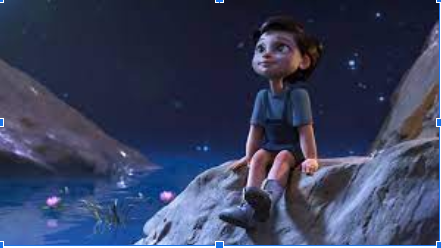
3D animation is a crucial component in creating stunning, captivating drawings that attract buyers. It is an effective strategy for engaging clients and giving them a convincing and realistic portrayal of a product.
3D animations perform more than describing a product to the spectator. Customers are assisted in visualizing how the product will function in their house by being shown how it operates. They offer the details required for those not proficient at reading 2D drawings to grasp a project in engineering, product design, drafting services, and architecture.
This post strives to give you an overview of 3D animation and provides a list of the leading software that 3D animators employ effectively. So, read on!
3D Animation: What is it?
3D animation of a boy sitting on a rock. Image source: Autodesk
Making moving three-dimensional graphics for a digital environment is known as 3D animation. These images are produced using 3D software, enabling animators to create computer-generated things that appear to be 3D, even on a 2D surface. An animated figure from a video game or an automobile in advertising might appear to be moving across three dimensions using visual effects and perfect timing. Let’s have a closer look at the procedure:
- Model building: Animators construct 3D objects that will be the foundation for animation during the modeling stage. A modeling tool is required to create this type of animation. A 3D mesh is made by reshaping and perfecting a primitive, or a simple item, into the desired shape. Then, information like color and texture is added to the 3D models. The next step is a procedure called “rigging,” which creates a skeleton for the animation figure so it can move.
- Animation and layout: A 3D animator won’t start the animation process until the aforementioned processes are finished. They are now able to maneuver a 3D object. Other methods include utilizing motion capture data or keyframes, which involve moving the object frame by frame.
- Rendering: The animator can proceed to render when the animation, lighting, and camera angles are all right. The intended graphics are developed and exported throughout this phase. The final depiction of the 3D character will be altered to account for light and shadow, reflections, transparency, and other elements.
How professionals use 3D animation in game character design process
In the field of 3D animation, the creation of game characters is a combination of art and technology. The process of creating a 3D character involves not only sculpting and texturing but also giving it personality and ensuring its movements are smooth. This whole procedure can be significantly optimized with the help of a specialized 3d character design studio. These studios offer a complete set of services, from concept development to final rendering, ensuring that each character resonates with the target audience. By leveraging the expertise of a 3D character design studio, game developers can ensure that their characters are not only visually amazing but also move and interact in a realistic and engaging manner.
Software Used by Professional 3D Animators
- SelfCAD
3D model of an elephant created using SelfCAD. Image source: 3DWithUs
With a simple and intuitive interface and plenty of learning resources, SelfCAD is explicitly designed for those with no prior CAD experience. As well as being one of the most accessible pieces of 3D modeling software, it can also be used in your browser.
SelfCAD is an affordable 3D modeling software for online 3D modeling, rendering, lighting, and more. It can accommodate any skill level. The SelfCAD software interface is straightforward and easy to use. You can use this software whether you are an entrepreneur, freelancer, or student. SelfCAD is a 3D modeling software that allows you to create 3D objects, scenes, and designs just like traditional CAD software. With a little knowledge of 3D design, you can create beautiful designs to solve user experience problems.
SelfCAD has lots of great tutorials to help you get started. Udemy has interactive tutorials, YouTube videos, and beginner 3D modeling courses that make it easy to start with 3D modeling, regardless of experience.
SelfCAD is free; users are given a 10-day free trial with full access to all tools. After the 10-day free trial, you can continue with the free version with limited features or subscribe to the premium version.
- Maya
A 3D model of a man’s face created using Maya. Image source: Autodesk
Maya is popular among 3D animators due to its highly flexible user interface. The Halo series of video games and several feature films, including Transformers, Harry Potter, South Park, and Game of Thrones, all utilized it.
In Maya, 3D models are represented by nodes that detail their connections and characteristics. This robust 3D animation program enables intricate adjustments with only a few clicks.
Maya’s powerful CG compositing application (“Match Mover”), a hallmark of professional 3D animation software, enables users to mix 3D-generated objects with motion data from movie sequences shot on location by monitoring the camera’s movement. A robust modeling tool for complicated items like fur, hair, clothes, fluids, and particles is also included.
- Mixamo
3D model of movie creatures. Image source: 3D Warehouse – SketchUp
By automatically building rigs for bipedal figures, the web tool Mixamo has the potential to accelerate the 3D animation process. Manually assembling a skeleton may be difficult since the weights for each bone must be painted one at a time.
Users input their 3D models into this 3D animation program and identify important features like knees and elbows. Then Mixamo works its magic to produce an elaborately weighted and skinned rig prepared for 3D animation.
- Blender
If you’re seeking a 3D animation and design solution, Blender is a solid substitute. It is free software that may be used to make animated movies, video games, and other things like visual effects. It also allows manual and automatic tracking.
The multi-platform program Blender runs on Macbooks, Windows, and Linux PCs. Its OpenGL-based user interface guarantees a fluid experience. It has a potent, unbiased rendering engine that produces stunning, ultra-realistic results.
Real-time viewport preview, GPU and CPU rendering, VR rendering, HDR lighting, and PBR shaders are all possible. Additionally, it comes with a complete set of modeling tools that make it simple to build, sculpt, and modify your models.
- Akeytsu
Akeytsu, a 3D design and animation program renowned for its artistry and ingenuity, is one of the most efficient programs on our list. This powerful and user-friendly keyframe and rigging animation tool works well for making 3D monsters, bipeds, and characters.
It gives designers a wide range of toolkits to develop massive volumes of 3D animation using simple software. Additionally, it has cycle animation features that significantly simplify designing.
Akeytsu includes a Spinner, sometimes known as the transformation center, since it has all the instruments required to produce high-quality work. The direct model integration is also provided, reducing the time spent moving back and forth when designing.
- After Effects by Adobe
Adobe After Effects is a fantastic 3D animation program available. It is a creative compositing and animation tool for designers, animators, and compositors. Abode After Effects is used in the post-production process for creating movies and television.
Most people find its complicated features terrifying, but it unquestionably has some simple functions that may be utilized for simple 2D animated films.
- Motionbuilder
Autodesk’s Motionbuilder is a 3D animation program designed for professionals. It blends motion capture, virtual production, and keyframe animation.
You may animate 3D characters in real-time that are particularly suited for game creation and animated films with this 3D animation program. With its many tools, motion capture data may be retargeted to rapidly and consistently adjust even the smallest elements in the character’s motions.
- Cinema 4D
Cinema 4D is renowned for being simple to learn and use if you’re searching for ease of usage. The real-time viewport of this 3D animation program is bewildered by the depth of field and screen space reflections thanks to OpenGL, making it simpler to manipulate these effects. Because this view looks so beautiful, Cinema 4D enables you to export preview renderings so you may submit them to clients for approval.
Now that the real-time viewport supports the Body paint tool, you can see the effects of your texture changes as you make them. A LOD tool in Cinema 4D simplifies objects depending on their proximity to the camera and other variables to speed up overall rendering.
- Terragen
Terragen was explicitly made for creating and visualizing photorealistic landscapes. Thanks to a robust procedural node system, the user has complete control over his creation.
A powerful shader system that permits complex surface modification and texturing are used to build the landscape. Your scene comes to life with detailed controls for volumetric clouds, fog, sky, the sun, and stars. Additionally, you may add a variety of pre-made trees, rocks, and other items to the scene using this 3D animation program to increase its overall authenticity.
- Dragon frame
Dragon frame is an industrial-grade stop-motion animation program. A manifestation of Dragon frame’s ability may be found in the stop-motion film Coraline. Dragon frame works by outlining motion routes with sketching tools as you plan your animation.
You can use the X-sheet in the side panel to keep track of your progress. You can also view reminders and notes while adjusting timing and reference videos on the screen. You can use these videos as a guide for your animation by changing the opacity, using chromakey, or picking out specific elements that catch your eye.
- Harmony
It is the “industry’s top 2D animation program,” according to Harmony. Given that it has won two Emmys for 2D animation software, the Canadian business behind it, Toon Boom Animation, undoubtedly has some impressive credentials. For example, the SpongeBob Movie: Sponge Out of Water and The Simpsons employed Harmony.
The program is offered in three different versions: Essentials, Advanced, and Premium. These versions range from basic animation components to sophisticated capabilities fit for professionals.
Harmony 20 is the most recent version. It adds to the software’s existing wide range of features with additional lighting and shading, sophisticated color management, color effects nodes, and snapping alignment guides. This 2D animation program offers a lot, including sophisticated brush engines, special effects and compositing, deformers, 2D/3D integration, and pipeline integration.
Conclusion
Now you know the most favored software that professionals employ to create 3D animation. If you are into 3D animation, this post will be handy for you.

